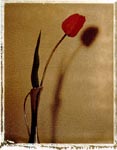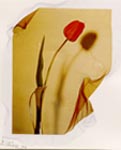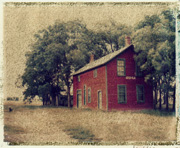 Polaroid image and emulsion transfers are alternative photographic processes which
cross the boundaries of painting, printmaking, and photography. Both are utilizing
peel-apart Polaroid film. An image is exposed onto Polaroid film by
means of a slide printer, camera or enlarger.
Polaroid image and emulsion transfers are alternative photographic processes which
cross the boundaries of painting, printmaking, and photography. Both are utilizing
peel-apart Polaroid film. An image is exposed onto Polaroid film by
means of a slide printer, camera or enlarger.
In the case of Image transfer, the film is pulled apart before complete development and the dye-laden negative is rolled onto another surface, such as watercolor paper. The dyes develop onto the other surface and the image is transferred. The image may then be manipulated and handcolored if desired. Each image is unique due to the physical properties of the transfer process. Polaroid image transfer provides an extremely versatile vehicle for the visual artist, allowing for images with a painterly quality, as well as partially rendered images.
 Polaroid emulsion transfer(emulsion lift) uses the same film and equipment,
however, the results are completely different. The image is developed fully onto
the positive print of the Polaroid film. The image layer of the print (the emulsion)
is then removed with hot water and can be placed onto virtually any surface, including
three-dimensional surfaces. The transparent emulsion can be sculpted, stretched
and torn into different shapes, then handcolored if desired. The creative
possibilities are limitless.
Polaroid emulsion transfer(emulsion lift) uses the same film and equipment,
however, the results are completely different. The image is developed fully onto
the positive print of the Polaroid film. The image layer of the print (the emulsion)
is then removed with hot water and can be placed onto virtually any surface, including
three-dimensional surfaces. The transparent emulsion can be sculpted, stretched
and torn into different shapes, then handcolored if desired. The creative
possibilities are limitless.
My fascination with Polaroid transfer started when I tried to learn large format photography and played with Super Graphic, an old 4x5 press camera. As a result I produced plenty of poor Polaroid pictures. Some of them looked much better when emulsion was transferred to watercolor paper! Grapes, Daffodil, Flute, and A Cup of Tea, are examples of these early emulsion transfers. Two others from the presented emulsion transfers,Sunset in Canyonlands, and Cliff Palace, were made from slides.
 Much later, I started to experiment with an image transfer
technique. All my image transfers have been made so far from 35 mm color or b&w slides
using a Daylab II slide printer with 4x5 base and Polaroid type 59 film. I have tried
wet transfer on various hot and cold press watercolor papers. Most of the transfers
are made on hot press Lanaquarelle paper but my favorite one is a cold press
Fabriano Artistico paper with a unique
linear texture visible, e.g., in Garlic I or
Strauss Cabin images.
An original slide picture of the garlic transfer can be seen in
The Garlic Symphony gallery. I have not felt in love
with Arches paper yet. Sometimes, I use the Polaroid positive, left after image transfer,
for emulsion transfer(Cliff Palace).
Much later, I started to experiment with an image transfer
technique. All my image transfers have been made so far from 35 mm color or b&w slides
using a Daylab II slide printer with 4x5 base and Polaroid type 59 film. I have tried
wet transfer on various hot and cold press watercolor papers. Most of the transfers
are made on hot press Lanaquarelle paper but my favorite one is a cold press
Fabriano Artistico paper with a unique
linear texture visible, e.g., in Garlic I or
Strauss Cabin images.
An original slide picture of the garlic transfer can be seen in
The Garlic Symphony gallery. I have not felt in love
with Arches paper yet. Sometimes, I use the Polaroid positive, left after image transfer,
for emulsion transfer(Cliff Palace).
 After initial experimentations with the technique, I am currently working on several
personal projects. Images from the Past include
historic sites from the Northern Colorado and other places which
have attracted my attention in the vicinity of Fort Collins. This project is getting
more and more serious as I am getting more involved in tracking the remains of
prairie ghost towns.
My images in this series are inspired by beautiful books of
Stephen Rothfeld (French Dreams, Italian Dreams, Irish Dreams).
My another projects include Aspen Grove series, which
is not very surprising if you live in
Colorado, adobe churches of New Mexico, and
some architecture abstracts.
After initial experimentations with the technique, I am currently working on several
personal projects. Images from the Past include
historic sites from the Northern Colorado and other places which
have attracted my attention in the vicinity of Fort Collins. This project is getting
more and more serious as I am getting more involved in tracking the remains of
prairie ghost towns.
My images in this series are inspired by beautiful books of
Stephen Rothfeld (French Dreams, Italian Dreams, Irish Dreams).
My another projects include Aspen Grove series, which
is not very surprising if you live in
Colorado, adobe churches of New Mexico, and
some architecture abstracts.
 The Polaroid transfer technique gives me occasion to reexamine some of my quite
old slides and photographs. The original picture of an old Polish sail yacht,
"Zew Morza" (Call of the Sea), was shot more
than 15 years ago when I used to sail on the Baltic Sea. This picture has
a special meaning to me since "Zew Morza" rests now on the bottom of the Mediterranean
Sea. Recently, I started to re-photograph old family photographs and then use them
for transfers. It is just a beginning of my Family Album.
Equally personal is my newest series Returns to Poland.
The Polaroid transfer technique gives me occasion to reexamine some of my quite
old slides and photographs. The original picture of an old Polish sail yacht,
"Zew Morza" (Call of the Sea), was shot more
than 15 years ago when I used to sail on the Baltic Sea. This picture has
a special meaning to me since "Zew Morza" rests now on the bottom of the Mediterranean
Sea. Recently, I started to re-photograph old family photographs and then use them
for transfers. It is just a beginning of my Family Album.
Equally personal is my newest series Returns to Poland.
How to start with Polaroid transfers?
For beginners, I would, recommend to visit
Polaroid web pages first.
They have some instructions on-line. Polaroid used also to have two free booklets
on Polaroid transfers and SX-70 manipulations: "{Inspiration} A Step-By-Step Guide" and
"Polaroid Guide to Instant Imaging - Advanced Image Transferring".
Call Polaroid at 1-800-343-5000.
Then, I would suggest to examine the on-line book on Polaroid transfers by Holly Dupre. There are also two great books published by Amphoto: Polaroid Transfers by Kathleen Thormod Carr and Creative Photo Printmaking by Theresa Airey and the newest book Photographer's Guide to Polaroid Transfers by Christopher Grey.
You are welcome to visit my "Polaroid transfer & manipulation resources" to find more links to instructional places, exhibitions, workshops, mailing lists, books and the guest gallery. Finally, you can post your questions to Polaroid transfer discussion forum.
contact: | other pages by Marek Uliasz